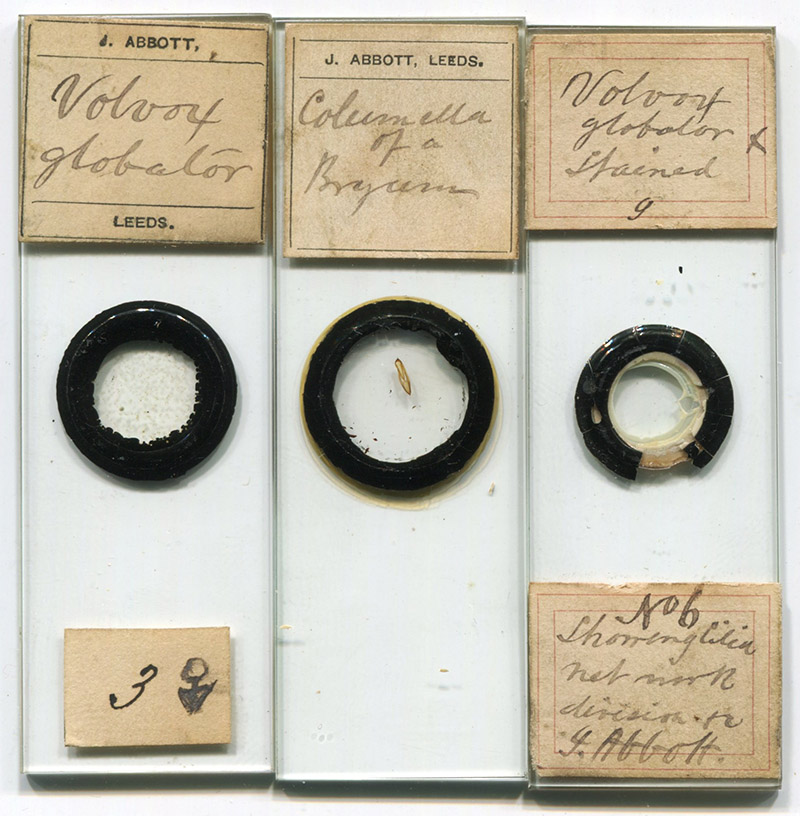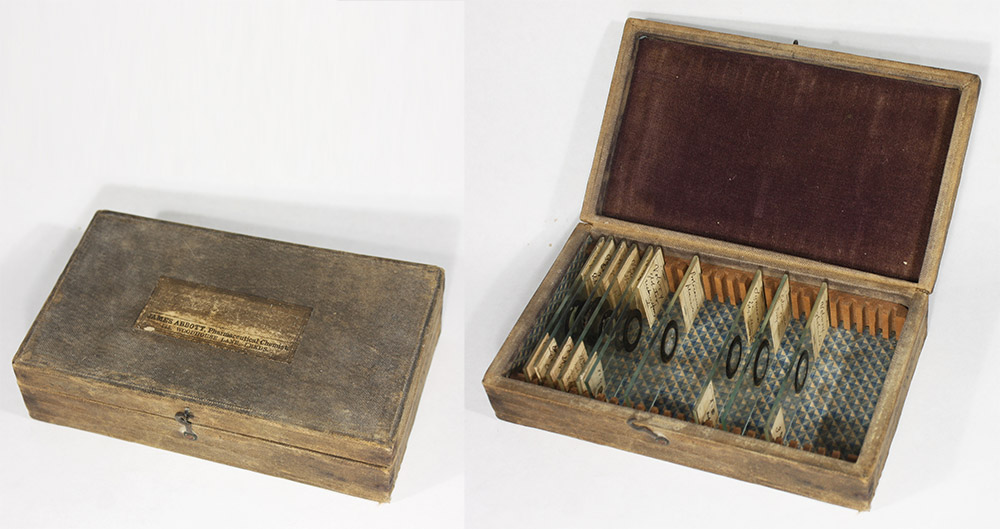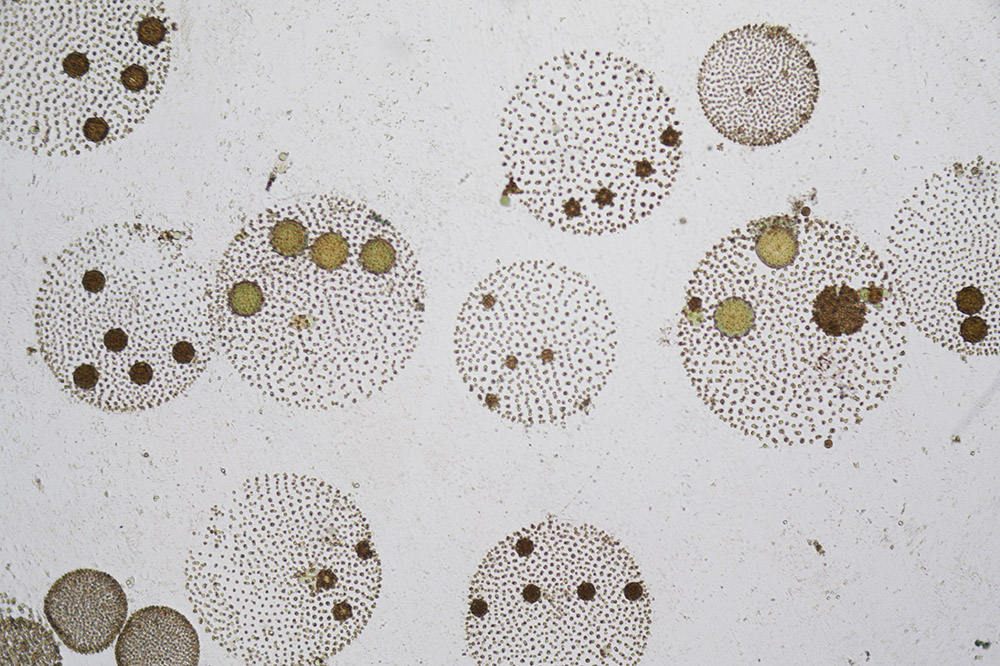
Figure 1. Microscope slides by James Abbott, all ca. 1878.
James Haynes Abbott, 1832 - 1889
by Brian Stevenson
last updated December, 2018
James Abbot was a pharmaceutical chemist with strong interests in microscopy and botany: he was an early member and frequent officer of the Leeds Naturalists' Club & Scientific Association, Demonstrator in the Biology Department of Yorkshire College, and retailer of microscope slides of his own construction (Figures 1-3).

Figure 1.
Microscope slides by James Abbott, all ca. 1878.

Figure 2.
A case of slides by Abbott, with James Abbott’s label affixed to the lid. Some slides bear dates of 1878. The majority are of Volvox globator, and the word "Volvox" is written on the label. When acquired, the box also contained several slides by George Chantrell, of Liverpool. Chantrell gave a presentation on Volvox to the Microscopical Society of Liverpool on June 7, 1878, in which he used “mounted slides of … stained specimens by Mr. James Abbott, of Leeds”. This case was undoubtedly Chantrell’s, and is evidence that Abbott sold microscope slides.

Figure 3.
Volvox globator, from a ca. 1878 slide by James Abbott (see Figure 1). The delicate specimens have held up very well over the past 140+ years.
James Abbott was born on November 7, 1832, in Leeds, Yorkshire. His February 11, 1833 baptism record listed him as “James Haynes son of Mary Abbott, spinster”, and did not name his father. Whether that was an error is not clear. However, in the 1851 census, he is listed with mother Mary and father John Abbott, and a younger brother, John. Father John worked as a “book keeper & cloth trader”.
The 29-year old James was listed in the 1861 census as being a “chemist and druggist”, living with his parents and brother. Their address was 59-60 Woodhouse Lane, Leeds. According to the 1869 Post Office Directory of Chemists and Druggists, James opened his first chemist’s shop at his parent’s house. He became a certified Pharmaceutical Chemist in 1869. Within a few years, he relocated to 145 Woodhouse Lane (or, the street numbers changed).
Abbott joined the Leeds Naturalists' Field Club & Scientific Association in April, 1870. One of the club’s notable presentations that year was Abbott’s talk on "Animalculae".
Simultaneously, Abbott was a member of an informal group, described as “For some years a private Scientific Association, consisting of five members, viz: Messrs. James Abbott, James Wm. Davis, Thomas Hick, F. Arnold Lees and William Todd, but having no rules or formal organization, save that Mr. Abbott acted as chairman and Mr. Hick as convener, had been in the habit of meeting weekly at the residence of one or other of its members, for the purpose of reading papers and discussing matters of scientific interest. This society gradually merged itself, about this date (ca. 1872), by a process of natural absorption into the Leeds Naturalists' Field Club, of which most of its members were already active constituents”.
Microscopist Henry Pocklington, a society colleague of Abbott’s, wrote an article in The English Mechanics and the World of Science in 1873 on a slide-making cement that had been invented by American John G. Hunt. The paper ended with, “I have to thank my friend, Mr. James Abbott, for calling my attention to a reprint of Dr. Wood's articles in the current number of Grevillea. Some slides prepared by Mr. Abbott With the new cement certainly seem as though they would stand any fair use, and the ordinary atmospheric influences”.
The Leeds Naturalists' Field Club & Scientific Association formed a Microscopical Section in 1874, and James Abbott was elected as the first President. The section had 22 members, and met every two weeks. After a while, though, it became clear that the club did not have enough members to carry a biweekly section meeting and a weekly club meeting, and the section was disbanded.
Abbott was elected Vice President of the club in 1875, with Henry Pocklington serving as President. Abbott was elected to the presidency in 1877.
In addition to his amateur work for his own edification and for sharing with his club, Abbott evidently produced slides for commercial sales. Figure 2 (above) illustrates a slide box with Abbott’s label that was acquired ca. 1878 by George Chantrell, the President of the Liverpool Microscopical Society, for his research on Volvox globator.
In 1886, the Leeds Chemists’ Association elected James Abbott as their Vice President.
James Abbot died on January 8, 1889, barely 56 years old. His wife, Eliza, continued the chemists’ business, with the help of a hired manager. She formed a partnership with James Anning in 1894, which dissolved in 1898 with Anning continuing the business alone.
Resources
Baptism record of James Abbott (1833) Paris records of St. Peter, Leeds, accessed through ancestry.com
Chemist and Druggist (1894) “The executors of the late Mr. James Abbott, pharmaceutical chemist, 145 Woodhouse Lane, Leeds, have taken into partnership their manager, Mr. James J. Anning, and the business is now carried on under the style of Abbott & Anning”, Vol. 45, page 433
Crooke, George F. (1883) On cases of bacilli in scarlet fever, “I have to thank Dr. Jacob, the visiting physician to the hospital, for his courtesy in placing his cases at my disposal, and also my friend Mr. James Abbott, of this town, whose practical knowledge of microscopy was of great assistance to me when looking over the slides with higher powers”, The Lancet, pages 432-434
England census and other records, accessed through ancestry.com
The English Mechanic and the World of Science (1874) Leeds Naturalists’ Society - Microscopical Section, Vol. 18, page 591
The English Mechanic and the World of Science (1878) Microscopical Society of Liverpool, Vol. 27, page 365
Kelly’s Directory of Chemists and Druggists (1885) “Abbott James, 145 Woodhouse lane”, page 437
Leeds Naturalists' Club & Scientific Association, Annual Report (1870)
Leeds Naturalists' Club & Scientific Association, Annual Report (1871)
Leeds Naturalists' Club & Scientific Association, Annual Report (1872)
Leeds Naturalists' Club & Scientific Association, Annual Report (1874)
Leeds Naturalists' Club & Scientific Association, Annual Report (1875)
The London Gazette (1898) “Notice is hereby given that the Partnership heretofore subsisting between us the undersigned Eliza Abbott and James John Anning carrying on business as Chemists and Druggists at Number 145 Woodhouse-lane in the city of Leeds under the style or firm of Abbott and Anning has been dissolved as and from the first day of July 1898 by mutual consent. All debts due to and owing by the said late firm will be received and paid by the said James John Anning who will continue the business at the above address. - Dated the 13th day of July 1893”, page 4391
The Naturalist (1877) Leeds Naturalists’ Club and Scientific Association, Vol. 3, pages 27, 61-62, and 95-96
Paisley, Peter B. (2011) William Barwell Turner: the later years, Micscape, November issue
The Pharmaceutical Journal (1886) Leeds Chemists’ Association, page 362
Pocklington, Henry (writing as “H.P.H.) (1873) New cement for microscopical objects, English Mechanic and the World of Science, Vol. 18, page 365
The Post Office Directory of Chemists and Druggists (1869) “Abbott James, 59 Woodhouse lane”, page 271
Probate of the will of James Abbott (1890) “8 January. The Will of James Abbott late of 145 Woodhouse-lane Leeds in the County of York Pharmaceutical Chemist who died 2 December 1889 at 145 Woodhouse-lane was proved at Wakefield by Eliza Abbott Widow the Relict (during Widowhood) and James Arthur Abbott Student of Medicine the Son both of 145 Woodhouse-lane the Executors. Personal Estate £1868 19s 3d”, accessed through ancestry.com
The Registers of Pharmaceutical Chemists (1885) “1869, Feb. 24, Abbott James, 145 Woodhouse Lane, Leeds”
The Year-Book of Pharmacy (1877) “Abbott, Mr. J., 145, Woodhouse Lane, Leeds”